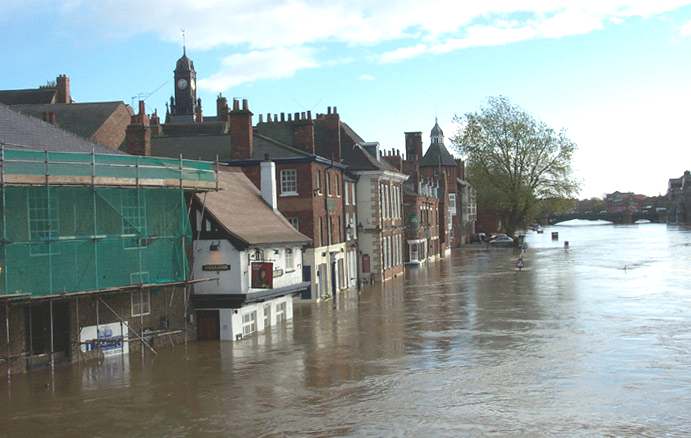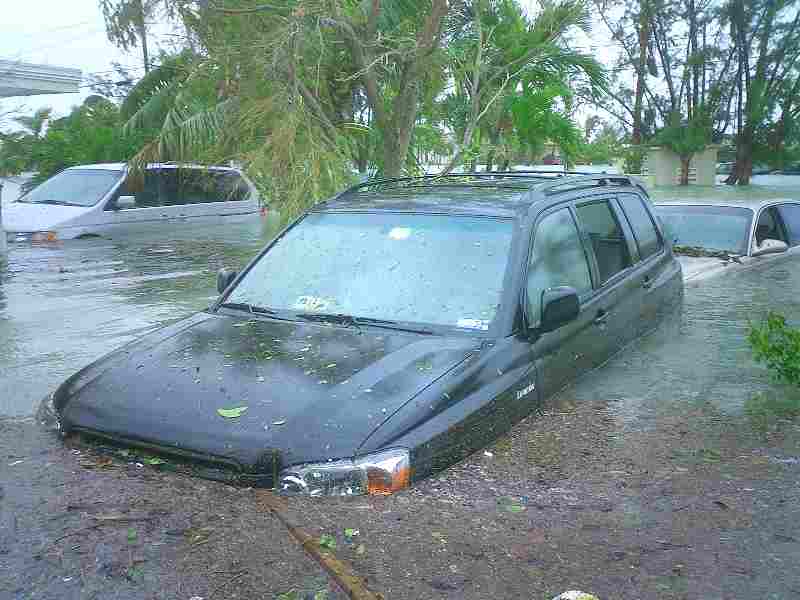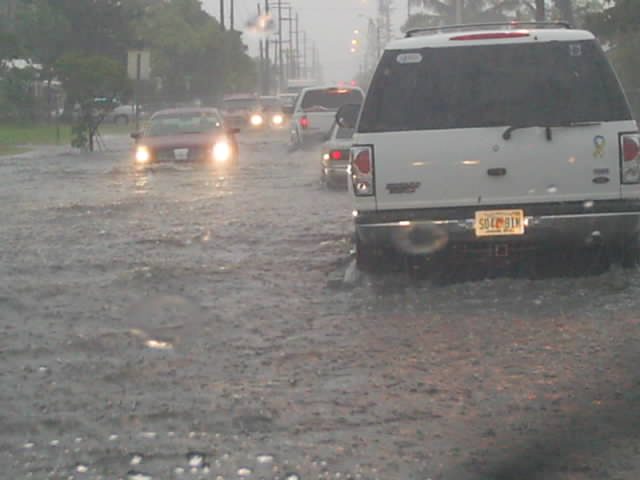|
FLOODS
|
|
|
HOME | BIOLOGY | FILMS | GEOGRAPHY | HISTORY | INDEX | MUSIC | SOLAR BOATS | SPORT | SPONSORS |
|
|
A flood (in Old English flod, a word common to Teutonic languages; compare German Flut, Dutch vloed from the same root as is seen in flow, float) is an overflow of water, an expanse of water submerging land, a deluge. In the sense of "flowing water", the word is applied to the inflow of the tide, as opposed to the outflow or "ebb". The Flood, the great Universal Deluge of myth and perhaps of history is treated at Deluge in mythology.
Flooding - burst river banks in Lewes, England 2000
Main causes
Floods from the sea can cause overflow or overtopping of flood-defences like dikes as well as flattening of dunes or buffs. Land behind the coastal defence may be inundated or experience damage. Floods from sea may be caused by heavy storm (storm surge), high tide, a tsunami or a combination thereoff. As most urban communities are located near the coast, this is a major threat around the world.
Many rivers that flow over relatively flat land border on broad flood plains. When heavy rainfall or melting snow causes the river's depth to increase and the river to overflow its banks, a vast expanse of shallow water can rapidly cover the adjacent flood plain. Flooding deposits silt on the flood plain, improving its fertility. Throughout history, this has attracted agriculture and other human development. In order to preserve these farms and cities, some rivers prone to flooding have had extensive and elaborate systems of dikes constructed along their shores and surrounding nearby cities. Unfortunately, by restraining flood waters, these dikes can result in much greater flooding downstream and in locations where they break. Because of the dikes the difference between water-level during flood and the surface of the inland increases and the potential devastation of the flood increases. The control of annual flooding, by dikes and by dams, also prevents the deposition of silt on the rich farmlands and can result in their eventual depletion. The annual cycle of flood and farming was of great significance to many early farming cultures, most famously to the ancient Egyptians of the Nile river and to the Mesopotamians of the Tigris and Euphrates rivers.
A flood happens when an area of land, usually low-lying, is covered with water. The worst floods usually occur when a river overflows its banks. An example of this is the January 1999 Queensland floods, which swamped south-eastern Queensland. Floods happen when soil and vegetation cannot absorb all the water ; water then runs off the land in quantities that cannot be carried in stream channels or kept in natural ponds or man-made reservoirs.
Periodic floods occur naturally on many rivers, forming an area known as the flood plain. These river floods usually result from heavy rain, sometimes combined with melting snow, which causes the rivers to overflow their banks. A flood that rises and falls rapidly with little or no advance warning is called a flash flood. Flash floods usually result from intense rainfall over a relatively small area. Coastal areas are occasionally flooded by high tides caused by severe winds on ocean surfaces, or by tidal waves caused by undersea earthquakes. There are often many causes for a flood.
Monsoon rainfalls can cause disastrous flooding in some equatorial countries, such as Bangladesh, due to their extended periods of rainfall. Heavy rain caused substantial damage across eastern Europe in the summers of 2003 and 2005. Normally riverine floods occur only in winter as a result of heavy rain in combination with melting of snow and glaciers in spring.
A flood can also occur when a volcanic eruption melts a large amount of ice and snow quickly. The Icelandic term "jökulhlaup" (literally "glacier-run") refers to the burst of water released by an eruption under a glacier. In the case where a snow-capped volcano erupts, the meltwater often picks up substantial amounts of volcanic ash and other debris to become a lahar.
Flooding caused by Hurricane Wilma in the Florida Keys
Hurricanes have a number of different features which, together, can cause devastating flooding. One is the storm surge (sea flooding as much as 8 metres high) caused by the leading edge of the hurricane when it moves from sea to land. Another is the large amounts of precipitation associated with hurricanes. The eye of a hurricane has extremely low pressure, so sea level may rise a few metres in the eye of the storm. This type of coastal flooding occurs regularly in Bangladesh.
In Europe floods from sea may occur as a result from heavy Atlantic storms, pushing the water to the coast. Especially in combination with high tide this can be damaging.
Under some rare conditions associated with heat waves, flash floods from quickly melting mountain snow have caused loss of property and life.
Undersea earthquakes, eruptions of island volcanos that form a caldera, (such as Thera or Krakatau) and marine landslips on continental shelves may all engender a tidal wave called a tsunami that causes destruction to coastal areas. See the tsunami article for full details of these marine floods.
Floods are the most frequent type of disaster worldwide. Thus, it is often difficult or impossible to obtain insurance policies which cover destruction of property due to flooding, since floods are a relatively predictable risk.
Flood defenses, planning, and management
In western countries, rivers prone to flooding are often carefully managed. Defenses such as levees, bunds, reservoirs, and weirs are used to prevent rivers from bursting their banks. Coastal flooding has been addressed in Europe with coastal defenses, such as sea walls and beach nourishment.
In some flood-prone areas with high population density, such as parts of the Netherlands, England, and New Orleans and Mississippi River Delta, planning laws have been used to prevent building on flood plains. In some cases, pressure from developers has caused these controls to be eroded, with an increasing number of new developments reliant on artificial defences for protection from floodwaters.
Bangladesh has not experienced catastrophic coastal flooding since 1995, but the country relies heavily on foreign support and technology to combat flooding. The United States has donated hurricane shelters to the country, and India provides the Bangladesh government with weather forecasting to give the country time to plan its response to hurricanes. Over the years small cults have formed called "Flood Patrol". These are groups of mostly young men out on the rural roads searching for the next flooded ditch or creek to drive through. Although not very safe, these few brave individuals risk their well being to bring you some of the best pictures of floods available.
Flooding caused by a severe thunderstorm in Hialeah, Florida
Significant modern floods
Although nature is normally blamed for the damage, the people are at least partly responsible for the presence of human activities in areas prone to the hazard of floods. Prevention is often aimed at containing floods with defenses, often increasing the potential damage in the long run. Nowadays, strategies to deal with floods more and more include evacuation strategies to avert damage.
LINKS
A taste for adventure capitalists
Solar Cola - a healthier alternative
|
|
|
This
website
is Copyright © 1999 & 2006 NJK. The bird The name '1824' is a trade mark of Solar Cola Ltd. All rights reserved. Max Energy Limited is an educational charity. |
|
|
AUTOMOTIVE | BLUEBIRD | ELECTRIC CARS | ELECTRIC CYCLES | SOLAR CARS |


